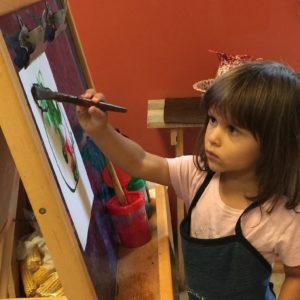
In the Montessori classroom, painting means more. What can you expect from your child’s first experiences with temperas, watercolors, and other paint products? Take a look at the answers to some of the top preschool painting questions.
How Is Painting Different in the Montessori Classroom?
Montessori classrooms (and the teachers) encourage exploration. Your child is central to their education and is the leader of the learning experience. This means you won’t find ready-made art projects that children are instructed to piece together. You also won’t find strict painting instruction or a teacher who tells your child what to create.
The Montessori approach favors process over product. This means your child will get the chance to make their own discoveries, paint what they choose, and play with the materials. If your child doesn’t end up with a portrait, picture, or another finished project, that’s fine. The goal isn’t to create a masterpiece. Instead, it’s to understand how the masterpiece is made.
What Types of Painting Materials Will the Preschooler Use?
The answer to this question depends on the school, classroom, and educator. The teacher will provide plenty of choices for your child to select from and explore. Again, art in the Montessori classroom focuses on the process and not the project. You won’t find project-based painting items such as paint by number pages or ready-made pictures to paint.
What will you find? It’s likely you’ll see:
Tempera paints. These washable paints are generally considered child-safe and easy for younger kids to use. These come in liquid and powdered (these require water to work) formulas. The teacher may provide the children with a rainbow of colors or let them mix the primaries.
Watercolors. Your child will use a brush and water to turn the hard or powdered paints into liquid. Watercolors are ideal for color exploration or as a way to integrate science (adding and mixing water with the paints) to art.
Finger paints. Finger paints are typically tempera paints (or a similar washable formula) that children use to explore through their sense of touch.
Paintbrushes. The teacher may provide your child with a variety of sizes and types of brushes to experiment with.
An easel. Your child can hang their paper on the easel and create an entirely new way to paint.
Along with these materials your child’s teacher may provide containers for your child to pour paint or water into as well as clean-up items. Not only can your child explore the process of painting, but they can also learn the practicalities of what happens after the artsy adventure is over.
What Will the Preschooler Paint?
There’s no one-size-fits-all painting project in the Montessori classroom. With a heavy focus on process, over product, the teacher won’t dictate what your child paints. Your child may choose to paint something (such as themselves, a parent, a pet, a vehicle, or anything else their mind dreams up) or they may just explore with color, shape, and texture.
How Does Painting Help the Child to Develop?
Art encourages development across several domains. When your child paints, they’ll get the chance to:
Build fine motor skills. As your child moves and manipulates the brush (or paint, if the child is finger painting) they’ll build eye-hand coordination, finger or hand strength, and dexterity.
Explore emotions. Art is an ideal medium for emotional expression — especially if the young child doesn’t have the vocabulary to fully express themselves verbally.
Problem-solve. Whether your child wants to mix their own paint colors or experiments with how to use textures of the medium, they’re problem-solving and building critical-thinking skills.
Preschoolers can also use paint to connect with other classroom areas. From story-time exploration to science, art (and painting) connects to the curriculum in creatively imaginative ways.
Is your child ready to start their Montessori adventure? Contact Miniapple International Montessori School for more information.

